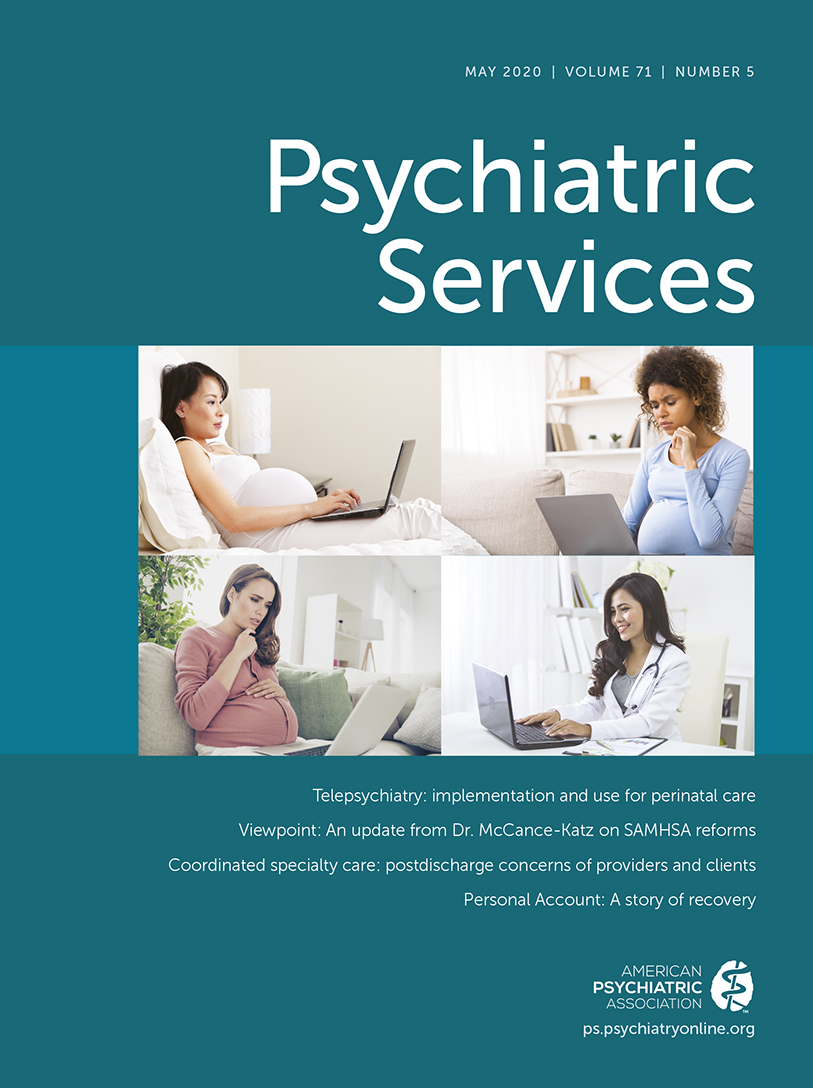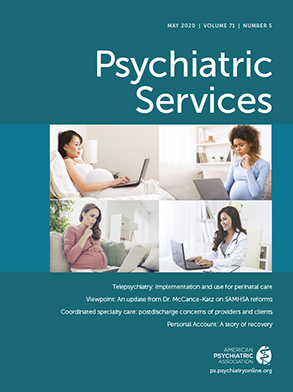Persons with disorders such as bipolar, depression, or schizophrenia are at a modestly increased risk of committing violence (
1–
3), with approximately half of victims being relatives (
4). Relatedly, studies have emerged examining violence by persons with psychiatric disorders toward intimate partners, caregivers, and other relatives (
5,
6). However, similar to the research bias in studies of community violence by this population, overwhelmingly more studies have examined violence by persons with psychiatric disorders toward relatives (
5,
6) than vice versa (
7). The primary objective of the present analyses, which examined online survey responses from a sample of community-residing persons in the United States who had psychiatric disorders, was to examine the rates at which respondents were victims of violence by reference relatives since first being diagnosed and in the past 6 months. Persons with psychiatric disorders who are victims of violence and perpetrators of violence overlap considerably (
8), and much of the violence involving this population, especially family violence, may be bidirectional. The secondary objective was to examine the extent to which victimization and perpetration of violence involving persons with psychiatric disorders and reference relatives co-occurred.
Methods
This study was approved by the institutional review board at the University of Pennsylvania and was conducted in accordance with the Declaration of Helsinki. Between December 2015 and March 2017, 523 adults diagnosed as having a mental illness completed an online survey. We conducted an online survey because surveys result in less social desirability bias than interviews (
9) and enable recruiting clinically and geographically diverse samples. Most people with serious and nonserious psychiatric disorders use the Internet (
10,
11).
Respondents were recruited from mental health organizations across the United States by using online (i.e., e-mail Listservs, e-newsletters, Web sites, and social media posts), and in-person (printed flyer) advertisements. Advertisements included a Web address where prospective respondents could obtain more information regarding the study and participate after consenting. Eligibility criteria included being at least 18 years of age, residing in the United States, and having a mental illness diagnosis, per self-report. Most respondents completed the survey in less than 20 minutes. Of those who began the survey, 85% completed it. There were no significant differences in the race-ethnicity or gender of completers versus noncompleters.
Victimization and perpetration of violence between respondents and reference relatives, since first diagnosis and in the past 6 months, were measured with questions closely adapted from the MacArthur Community Violence Instrument (MCVI) (
4). The MCVI differentiates acts of violence on the basis of severity, categorizing acts according to recently updated labels as either “minor violence” or “serious violence” (
12). Acts of minor violence were defined as battery that did not result in injury or involve the use of a weapon. Acts of serious violence were defined as battery resulting in injury or involving the use of a weapon or any act of threatening with a knife, gun, or other lethal object in hand. In a slight divergence from the MCVI, sexual violence was not measured because this study’s focus was physical violence. Three categories of violence outcomes were created, measured dichotomously (occurred versus did not occur): minor violence (at least one act of minor violence was reported but an act of serious violence was not), serious violence (at least one act of serious violence was reported with or without an act of minor violence), and any violence (at least one act of minor or serious violence was reported) (
12). Other variables were measured with straightforward questions. We computed simple descriptive statistics as well as chi-square and Fisher’s exact tests.
Results
Respondents reported that they became aware of the study through the National Alliance on Mental Illness (N=127, 24%), Depression and Bipolar Support Alliance (N=118, 23%), consumer-run organizations (N=68, 13%), Facebook groups pertaining to mental illness (N=58, 11%), inpatient or outpatient mental health treatment (N=37, 7%), the International Association of Peer Supporters (N=16, 3%), state division of mental health Listservs (N=12, 2%), a chronic suicide support forum (N=9, 2%), and We Search Together (N=7, 1%). Fourteen percent (N=71) did not respond or provided nondescript responses (e.g., “online”).
The mean±SD age of respondents was 43.1±14.39 years (range 18–73). Almost 80% (N=414) were female. In terms of race-ethnicity, 88% (N=460) of respondents were non-Hispanic Caucasian, 5% (N=26) were African American, 3% (N=14) were Hispanic of any race, 1% (N=7) were Asian, <1% (N=2) were Native American, and 3% (N=14) were of mixed race. Primary diagnoses were bipolar disorder (N=203, 39%), depression (N=174, 33%), anxiety-related disorder (N=64, 12%), schizophrenia/schizoaffective disorder (N=36, 7%), and other disorders (N=46, 9%), including posttraumatic stress, attention-deficit hyperactivity, borderline personality, and eating disorders. One-third of respondents were married (N=167), and 47% (N=251) had a college degree. The median category for annual income was $10,000–$19,999. Sixteen percent (N=83) had been hospitalized for a psychiatric disorder in the past year, and 47% (N=248) were not involved in the labor market.
The mean age of reference relatives was 50.32±16.89 years (range 18–87), and half were female (N=260). Their race-ethnicity closely resembled that of respondents, and the median annual income category was $20,000–$39,999. In relation to respondents, reference relatives were romantic partners (N=239, 46%), parents (N=143, 27%), siblings (N=53, 10%), or other relatives (N=88, 17%). Seventy percent (N=367) of respondents and reference relatives co-resided in the past 6 months.
Since respondents were first diagnosed as having a mental health condition, 15% (N=81), 9% (N=48), and 24% (N=129) reported having been the victim of minor, serious, and any violence, respectively, by reference relatives. Twenty-one percent (N=110), 5% (N=26), and 26% (N=136) reported having committed minor, serious, and any violence, respectively, toward reference relatives since first diagnosis.
More than 55% of respondents who reported perpetrating any violence since initial diagnosis also reported being the victim of any violence, and vice versa (
Table 1). Rates of respondents having perpetrated any violence toward reference relatives were significantly different based on relationship type (e.g., romantic partner, parents, siblings, other). Similarly, significant differences in rates of perpetration among respondents who were also victims were found on the basis of relationship type. Rates of victimization, perpetration, and their co-occurrence did not differ by diagnosis or sex of respondents.
Eight percent (N=44), 4% (N=23), and 13% (N=67) of respondents reported having been a victim of minor, serious, and any violence, respectively, by reference relatives in the past 6 months. Ten percent (N=51), 2% (N=13), and 12% (N=64) reported having committed minor, serious, and any violence, respectively, toward reference relatives in the past 6 months.
Approximately 40% of respondents who reported perpetrating any violence in the past 6 months also reported being the victim of any violence, and vice versa (
Table 2). Rates of having perpetrated any violence toward reference relatives in the past 6 months were significantly different based on relationship type. Rates of perpetration among respondents who were also victims also differed according to relationship type. Rates of victimization, perpetration, and their co-occurrence did not differ by diagnosis or sex of respondents.
Discussion
This is the first study we know of that investigated both victimization by and perpetration of family violence involving persons with psychiatric disorders and not exclusively involving intimate partners. Using a definition of physical violence similar to that of “any violence” in this study, the National Intimate Partner and Sexual Violence Survey estimated that 2.9% of women and 3.8% of men have been victims of physical violence by an intimate partner in the past year (
13). These estimates are in strong contrast to the results of this study: of respondents reporting on an intimate partner, 15% had been a victim of violence, and 20% had committed violence in the past 6 months. Rates of violence between non-intimate-partner family members are considerably lower than rates of violence involving intimate partners (
14); still, 4%−12% of respondents reporting on a non-intimate-partner relative indicated victimization or perpetration of violence in the past 6 months, with most rates being 8% or greater (
Table 2). These results agree with extant studies that have found that violence and conflict occur at elevated rates in families of persons with psychiatric disorders (
5,
7), surely reflecting considerable stress experienced by persons with psychiatric disorders and by their families.
This study makes a unique contribution by examining rates at which persons with psychiatric disorders were victims of violence and by contributing data that rates of perpetration and victimization were nearly identical. Much of the research on this topic has examined violence by persons with psychiatric disorders toward caregivers, primarily mothers (
6). This study did not specifically examine caregivers; however, this study found that reference relatives who were parents—nearly all were mothers providing care to respondents—were at least as likely to have been violent toward respondents as the converse.
We decided to collect data from persons with psychiatric disorders because the perspective of this population is largely absent in studies on this topic. Of possible report sources, self-reports from persons with psychiatric disorders yield a majority of recorded events of violence (
4). Additionally, estimates of violence risk relying on self-reports from persons with psychiatric disorders do not differ from those relying on official records (
3). Consequently, we believe the risk of respondents having underreported violence committed by them is likely modest. We consider our sample to be most representative of persons with mood disorders, particularly those who are members of mental health support organizations. Limitations of the sample were that it had disproportionately high levels of educational attainment and inadequate diversity regarding sex and race-ethnicity, which often occurs when recruiting from mental health support organizations.

